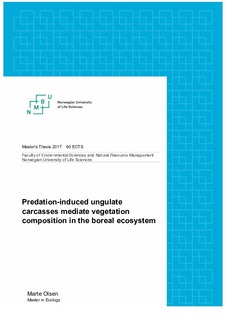| dc.description.abstract | Apex carnivores are mostly recognized for their effects on ecosystem processes through altering population dynamics and behaviour of their prey. Apex carnivores may also affect lower trophic levels through the distribution of ungulate carcasses. Such direct effects of predation on lower trophic levels are, however, poorly understood. Ungulate carcasses typically disturb soil and vegetation locally and enrich the soil with nutrients, which affect composition of the vegetation. In this study, I assessed vegetation composition in relation to carcasses of wolf-killed (Canis lupus) moose (Alces alces) in the boreal forest in southcentral Sweden. I compared composition of vascular plants, bryophytes and lichens at 12 carcass sites, each one paired with a nearby (25-50m) control site without carcass. I recorded the abundance of all species within nine vegetation plots at each carcass and control site, with one plot placed at the kill spot. Using generalized linear mixed models, I found that the carcasses created intense local disturbances and reduced both field (vascular plants) and ground cover (bryophytes and lichens), with the most dramatic effect in the centre of the carcass plot. Carcasses presence accounted for 11% of the explained variation in the species composition, although the effects were very local. Results from a detrended correspondence analysis revealed that forest age was the most important gradient in explaining patterns in species composition. Disturbance from carcasses was the second most important. I used indicator value analysis to identify winners and losers of carcass presence, and found that seedlings of Betula pubescens/pendual and Pinus sylvestris were more abundant on the carcass centre plots than elsewhere. Additionally, three mosses were positively affected by carcass disturbance (Pohlia nutans, Bryum sp., Plagiomnium ellipticum), and one lichen (Cladonia arbuscula) was identified as a loser. The disturbance from carcasses showed several similarities with uprooting of trees, as it releases competitive interactions and makes space available for species regenerating from the diaspore bank. Because uprooting’s are rare in the heavily managed forest, this may increase the importance of carcasses as disturbances in the boreal forest. My results
emphasize that apex predators can have important ecological roles other than numeric and trait mediated cascading effects, as predation events create local biogeochemical hotspots. This highlight the importance of conservation of apex predators in the ecosystem to keep ecosystem functioning intact. | nb_NO |

